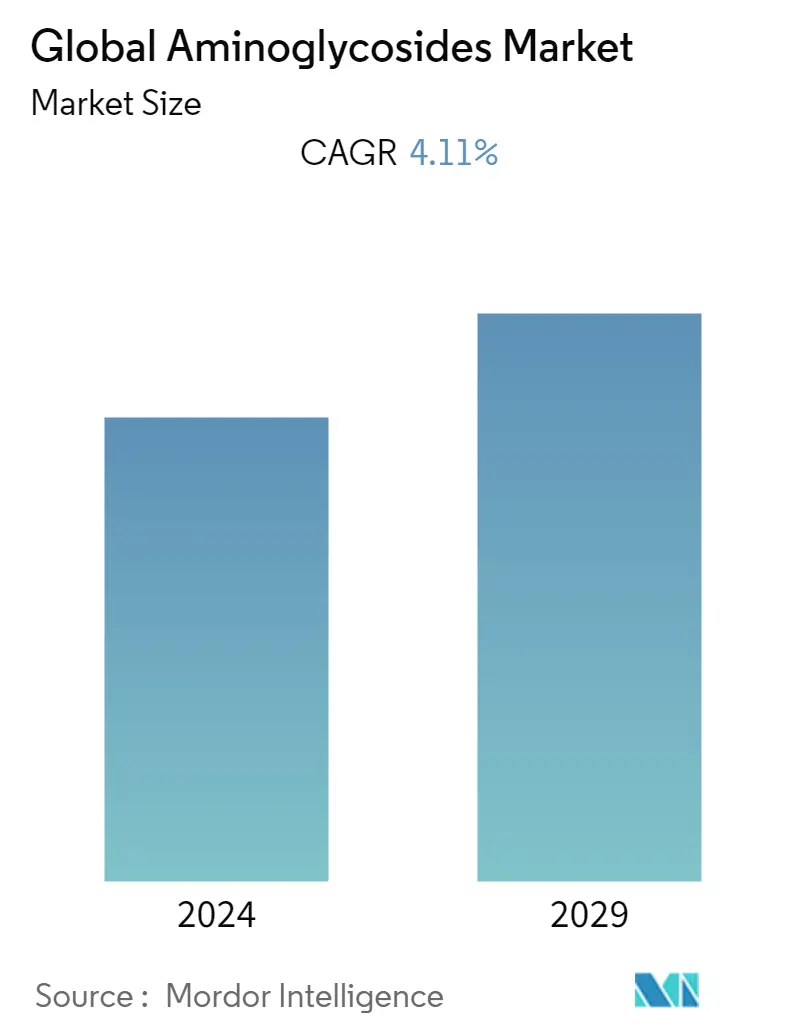Market Size of Global Aminoglycosides Industry

| Study Period | 2019 - 2029 |
| Base Year For Estimation | 2023 |
| CAGR | 4.11 % |
| Fastest Growing Market | Asia-Pacific |
| Largest Market | North America |
| Market Concentration | Low |
Major Players
*Disclaimer: Major Players sorted in no particular order |
Aminoglycosides Market Analysis
The aminoglycosides market is expected to record a CAGR of 4.11% over the forecast period (2022-2027).
The COVID-19 outbreak significantly impacted the healthcare sector. As per the article published in 2021 under the title 'Aminoglycosides and their potential as SARS-CoV-2 antivirals', as the defense mechanism implemented by aminoglycosides, it was anticipated to be worth researching as SARS-CoV-2 antivirals. Moreover, murine hepatitis virus (MHV) inhibition by the aminoglycosides hygromycin B (hygB) and neomycin has been demonstrated in vitro. Furthermore, as per the article published in 2021 under the title 'Aminoglycosides as potential inhibitors of SARS-CoV-2 main protease: an in silico drug repurposing study on FDA-approved antiviral and anti-infection agents', Aminoglycosides were likely to be used as a base to create powerful COVID-19 medicinal compounds. Hence, as per the factors mentioned above, COVID-19 had a significant impact on the loratadine market.
The major factors driving the market growth include the growing instances of animal disease outbreaks, leading to the high utilization of antibiotics, a rise in the aging population, and the increasing prevalence of bacterial infectious diseases. For instance, as per the article published in 2022 under the title 'Correlation between antibiotic consumption and the occurrence of multidrug-resistant organisms in a Malaysian tertiary hospital: a 3-year observational study', the study showed that broad-spectrum antibiotics and antibiotics against multidrug-resistant organisms (MRO) consumption increased significantly throughout in the studied region. In humans and animals, the usage of aminoglycosides in the treatment of different bacterial infections is increasing due to the presence of characteristics such as bactericidal activity against staphylococci and certain mycobacteria, which is expected to influence market growth.
Moreover, this class of antibiotics is found to be effective even when bacterial inoculum is large, and it is frequently used as a second line of defense against basic infection resistant to basic antibacterial. The increasing burden of tuberculosis is also expected to drive the demand for aminoglycosides, especially in low-income countries where the incidence is alarmingly high and there is a need for aminoglycosides. For instance, as per the World Health Organization (WHO) 2021 update, a total of 1.5 million people died from tuberculosis in 2020 (including 214,000 people with HIV). Globally, COVID-19 (after HIV/AIDS) is the second most lethal infectious disease, while tuberculosis is the 13th most common cause of death.
As per the facts mentioned above aminoglycosides, market is expected to grow over the forecast period. However, a reduction in the prescription rate of aminoglycoside antibiotics due to side effects associated with the usage of these drugs which include severe ototoxicity, nephrotoxicity, and neuromuscular blockade is expected to restrain the market growth.
Aminoglycosides Industry Segmentation
As per the scope of this report, aminoglycosides are highly potent antibiotics with several properties for the treatment of life-threatening infections. Aminoglycosides have concentration-dependent bactericidal activity by binding to the 30S ribosome that inhibits bacterial protein synthesis. The aminoglycosides market is segmented by product (Neomycin, Tobramycin, Gentamycin, Streptomycin, Kanamycin, Paromomycin, Amikacin, Verdamicin, Astromicin, and Hygromycin B), route of administration (parenteral, intra-mammary, topical, and oral), application (veterinary, skin infection, respiratory diseases, UTI and pelvic diseases, and other diseases), and geography (North America, Europe, Asia-Pacific, Middle-East and Africa, and South America). The market report also covers the estimated market sizes and trends for 17 countries across major regions globally. The report offers the value (in USD million) for the above segments.
| By Product | |
| Neomycin | |
| Tobramycin | |
| Gentamicin | |
| Amikacin | |
| Paromomycin | |
| Streptomycin | |
| Kanamycin | |
| Other Aminoglycosides |
| By Route of Administration | |
| Parenteral | |
| Intra-mammary | |
| Topical | |
| Oral |
| By Application | |
| Veterinary | |
| Skin Infection | |
| Respiratory Diseases | |
| UTI and Pelvic Diseases | |
| Other Diseases |
| Geography | ||||||||
| ||||||||
| ||||||||
| ||||||||
| ||||||||
|
Global Aminoglycosides Market Size Summary
The aminoglycosides market is poised for growth, driven by several key factors including the rising incidence of bacterial infections and the increasing demand for effective treatment options. The market is experiencing a surge in the utilization of aminoglycosides due to their bactericidal properties, particularly against staphylococci and certain mycobacteria. This class of antibiotics is gaining traction as a second line of defense against infections resistant to basic antibacterials. The growing burden of tuberculosis, especially in low-income countries, further propels the demand for aminoglycosides. Additionally, the market is witnessing increased research and development activities, particularly in relation to Gentamicin, which is widely used in both human and veterinary medicine for serious bacterial infections. The COVID-19 pandemic has also influenced the market, with aminoglycosides being explored for their potential antiviral properties, although side effects such as ototoxicity and nephrotoxicity pose challenges to their prescription rates.
In North America, the aminoglycosides market is expected to expand due to the rising incidence of bacterial infections and the need for early diagnosis and treatment. Government support and increased healthcare expenditure are also contributing to market growth. The market is moderately fragmented, with a mix of large and small pharmaceutical manufacturers, and the expiry of patent exclusivity has led to a rise in generic manufacturing, particularly in the Asia-Pacific region. Key players in the market include Cipla Limited, Pfizer Inc., AbbVie Inc. (Allergan PLC), Teva Pharmaceutical Industries Ltd, and Zoetis Inc. Recent regulatory approvals and clinical trials, such as those conducted by Padagis and Leiden University Medical Center, highlight ongoing efforts to enhance the efficacy and safety of aminoglycoside treatments. These developments, coupled with the increasing antibiotic resistance, are expected to drive the market forward over the forecast period.
Global Aminoglycosides Market Size - Table of Contents
-
1. MARKET DYNAMICS
-
1.1 Market Overview
-
1.2 Market Drivers
-
1.2.1 Growing Instances of Animal Disease Outbreaks Leading to High Utilization of Antibiotics
-
1.2.2 Increase in Aging Population
-
1.2.3 Increasing Prevalence of Bacterial Infectious Diseases
-
-
1.3 Market Restraints
-
1.3.1 Adverse and Toxic Reactions Associated with Aminoglycosides
-
-
1.4 Porter's Five Forces Analysis
-
1.4.1 Threat of New Entrants
-
1.4.2 Bargaining Power of Buyers/Consumers
-
1.4.3 Bargaining Power of Suppliers
-
1.4.4 Threat of Substitute Products
-
1.4.5 Intensity of Competitive Rivalry
-
-
-
2. MARKET SEGMENTATION (Market Size by Value - USD Million)
-
2.1 By Product
-
2.1.1 Neomycin
-
2.1.2 Tobramycin
-
2.1.3 Gentamicin
-
2.1.4 Amikacin
-
2.1.5 Paromomycin
-
2.1.6 Streptomycin
-
2.1.7 Kanamycin
-
2.1.8 Other Aminoglycosides
-
-
2.2 By Route of Administration
-
2.2.1 Parenteral
-
2.2.2 Intra-mammary
-
2.2.3 Topical
-
2.2.4 Oral
-
-
2.3 By Application
-
2.3.1 Veterinary
-
2.3.2 Skin Infection
-
2.3.3 Respiratory Diseases
-
2.3.4 UTI and Pelvic Diseases
-
2.3.5 Other Diseases
-
-
2.4 Geography
-
2.4.1 North America
-
2.4.1.1 United States
-
2.4.1.2 Canada
-
2.4.1.3 Mexico
-
-
2.4.2 Europe
-
2.4.2.1 Germany
-
2.4.2.2 United Kingdom
-
2.4.2.3 France
-
2.4.2.4 Italy
-
2.4.2.5 Spain
-
2.4.2.6 Rest of Europe
-
-
2.4.3 Asia-Pacific
-
2.4.3.1 China
-
2.4.3.2 Japan
-
2.4.3.3 India
-
2.4.3.4 Australia
-
2.4.3.5 South Korea
-
2.4.3.6 Rest of Asia-Pacific
-
-
2.4.4 Middle-East and Africa
-
2.4.4.1 GCC
-
2.4.4.2 South Africa
-
2.4.4.3 Rest of Middle-East and Africa
-
-
2.4.5 South America
-
2.4.5.1 Brazil
-
2.4.5.2 Argentina
-
2.4.5.3 Rest of South America
-
-
-
Global Aminoglycosides Market Size FAQs
What is the current Global Aminoglycosides Market size?
The Global Aminoglycosides Market is projected to register a CAGR of 4.11% during the forecast period (2024-2029)
Who are the key players in Global Aminoglycosides Market?
Pfizer Inc., AbbVie Inc (Allergan Plc), Teva Pharmaceutical Industries Ltd, Zoetis Inc and Cipla Limited are the major companies operating in the Global Aminoglycosides Market.

